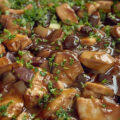While Tu B’Shvat, generally known as a Jewish holiday for trees, might seem like a very simple and straightforward holiday—traditionally many people eat fruit and plant trees as a way of celebrating—it may actually be one of the most mysterious of all the Jewish holidays.
For starters, it’s the only holiday celebrated by many Jews worldwide that is neither mentioned anywhere in the Hebrew Bible nor connected to some historical or miraculous event.
Tu B’Shvat is first mentioned in the first-ever codification of Jewish law called the Mishna, published around the year 200 CE. While listing four different New Year’s days in the Jewish calendar (Rosh Hashanah being one of them), the Mishna mentions that the 15th day of the Hebrew month of Shvat (“Tu” is Hebrew shorthand for the number 15) is the “New Year's Day for the Trees.”
New Year's Day for the trees? Why do trees need a New Year's day? (And how do they celebrate it?)
To make a long story short, in a number of places the Torah mentions tithes to be taken from produce grown in the Land of Israel, and fruit collected in one year cannot count as tithes for fruit collected in a different year. Tu B'Shvat is the date on the calendar chosen as the demarcation point distinguishing between one year and the next.
That’s it. That was Tu B’Shvat in ancient Israel. Basically, it was a tax day on fruits.
But if that’s the case, where did the celebrations associated with this day come from? Who celebrates tax day?
The truth is that Tu B’Shvat was not celebrated at all for most of Jewish history, especially after the Jewish people were exiled from Israel in the first century CE and no longer were tithing fruit in their homeland. That changed in the 16th century when a group of Kabbalists living in the city of Tzfat in northern Israel got together and created the “Tu B’Shvat Seder,” which is a ritual that infuses this otherwise mundane day on the Jewish calendar with deep spiritual meaning and great celebration.
In recent decades, more and more Jewish communities around the world have begun celebrating Tu B’Shvat with communal Tu B’Shvat Seders filled with wine, food, and festivities.
Let’s take a look at what the Kabbalists of Tzfat created 500 years ago.
First of all, the Tu B’Shvat Seder is modeled after the Passover Seder in that there are four glasses of wine, or grape juice, that you drink throughout the seder. The Kabbalists linked these four glasses to the “four worlds” mentioned in Kabbalah as well as to the four seasons and the four elements (fire, water, wind, and earth), creating four different stages of the Tu B’Shvat Seder experience. In each world, or stage, a different color of wine is drunk, a different kind of fruit is eaten, and different teachings are shared, making the seder into a very unique Jewish fruit and wine party.
In the first stage, a glass of white wine is poured representing winter. The fruits that are eaten are fruits with peels, as well as nuts with shells (bananas, oranges, almonds, etc.). According to Kabbalah, peels and shells spiritually represent that which covers or hides the true essence of something or someone. They also represent the barriers that stand in your way of accomplishing your dreams and goals, barriers you are meant to, and need to, overcome in order to reach your highest potential. But there is a positive aspect of peels and shells as well; they protect that which is precious from potentially harmful external forces until the right time has come to expose what’s on the inside.
In the second stage, a glass of white wine with a splash of red wine is poured representing spring. The fruits that are eaten have no peel but do have an inner pit that can’t be eaten (plums, peaches, olives, dates, etc.). These fruits spiritually represent a lowering of your guard against the outside world and a stronger inner faith in your ability to stand up against whatever comes your way. The inner pit can also represent a certain level of stubbornness or withdrawal from the world that may or may not be beneficial, depending on the situation.
In the third stage, a glass of red wine with a splash of white wine is poured representing summer. The fruits that are eaten have no peel or shell and no inner pit (strawberries, blueberries, etc.) . These fruits can be eaten in their entirety and spiritually represent a shedding of all external and internal inhibitions and a total trust and faith in being your fullest self in the world without fear or worry.
In the fourth and last stage, a glass of all red wine is poured representing fall. There are no fruits eaten in this stage since this stage represents a reality that is completely spiritual. In place of fruits, fragrant incense or oils are passed around for everyone to smell since, for various reasons according to Kabbalah, the sense of smell is the most spiritual of all the five senses.
With all of this eating and drinking, it might seem that Tu B’Shvat is one big Jewish party without the typical requirements and rules that accompany most other holidays. And, on one level, this is true. But for the Kabbalists who created it, the Tu B’Shvat Seder was a very spiritual, and even serious, experience. For them, the drinking and eating done during the seder offered an opportunity to infuse spirituality into the mundane, something they saw as one of the major goals of Judaism. That’s why, at the seder, they said the blessings over the wine and the fruit with great focus and intention for they believed that not only what they eat, but also how they eat, has a tremendous impact on their souls, and even the entire world.















